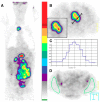Exploring Tumor Heterogeneity Using PET Imaging: The Big Picture
- PMID: 31480470
- PMCID: PMC6770004
- DOI: 10.3390/cancers11091282
Exploring Tumor Heterogeneity Using PET Imaging: The Big Picture
Abstract
Personalized medicine represents a major goal in oncology. It has its underpinning in the identification of biomarkers with diagnostic, prognostic, or predictive values. Nowadays, the concept of biomarker no longer necessarily corresponds to biological characteristics measured ex vivo but includes complex physiological characteristics acquired by different technologies. Positron-emission-tomography (PET) imaging is an integral part of this approach by enabling the fine characterization of tumor heterogeneity in vivo in a non-invasive way. It can effectively be assessed by exploring the heterogeneous distribution and uptake of a tracer such as 18F-fluoro-deoxyglucose (FDG) or by using multiple radiopharmaceuticals, each providing different information. These two approaches represent two avenues of development for the research of new biomarkers in oncology. In this article, we review the existing evidence that the measurement of tumor heterogeneity with PET imaging provide essential information in clinical practice for treatment decision-making strategy, to better select patients with poor prognosis for more intensive therapy or those eligible for targeted therapy.
Keywords: PET; SUV; heterogeneity; nuclear medicine; radiomics; radiopharmaceuticals.
Conflict of interest statement
The authors declare no conflict of interest.
Figures





Similar articles
-
More advantages in detecting bone and soft tissue metastases from prostate cancer using 18F-PSMA PET/CT.Hell J Nucl Med. 2019 Jan-Apr;22(1):6-9. doi: 10.1967/s002449910952. Epub 2019 Mar 7. Hell J Nucl Med. 2019. PMID: 30843003
-
Quantitative studies using positron emission tomography (PET) for the diagnosis and therapy planning of oncological patients.Hell J Nucl Med. 2006 Jan-Apr;9(1):10-21. Hell J Nucl Med. 2006. PMID: 16617388
-
Correlation of simultaneously acquired diffusion-weighted imaging and 2-deoxy-[18F] fluoro-2-D-glucose positron emission tomography of pulmonary lesions in a dedicated whole-body magnetic resonance/positron emission tomography system.Invest Radiol. 2013 May;48(5):247-55. doi: 10.1097/RLI.0b013e31828d56a1. Invest Radiol. 2013. PMID: 23519008
-
New PET radiopharmaceuticals beyond FDG for brain tumor imaging.Q J Nucl Med Mol Imaging. 2012 Apr;56(2):173-90. Q J Nucl Med Mol Imaging. 2012. PMID: 22617239 Review.
-
PET-Based Personalized Management in Clinical Oncology: An Unavoidable Path for the Foreseeable Future.PET Clin. 2016 Jul;11(3):203-7. doi: 10.1016/j.cpet.2016.03.002. Epub 2016 May 2. PET Clin. 2016. PMID: 27321025 Review.
Cited by
-
Gene Abnormalities and Modulated Gene Expression Associated with Radionuclide Treatment: Towards Predictive Biomarkers of Response.Genes (Basel). 2024 May 26;15(6):688. doi: 10.3390/genes15060688. Genes (Basel). 2024. PMID: 38927624 Free PMC article. Review.
-
Correlations between baseline 18F-FDG PET tumour parameters and circulating DNA in diffuse large B cell lymphoma and Hodgkin lymphoma.EJNMMI Res. 2020 Oct 7;10(1):120. doi: 10.1186/s13550-020-00717-y. EJNMMI Res. 2020. PMID: 33029662 Free PMC article.
-
Innovative applications and future trends of multiparametric PET in the assessment of immunotherapy efficacy.Front Oncol. 2025 Jan 20;14:1530507. doi: 10.3389/fonc.2024.1530507. eCollection 2024. Front Oncol. 2025. PMID: 39902124 Free PMC article. Review.
-
Use of imaging to assess the activity of hepatic transporters.Expert Opin Drug Metab Toxicol. 2020 Feb;16(2):149-164. doi: 10.1080/17425255.2020.1718107. Epub 2020 Jan 23. Expert Opin Drug Metab Toxicol. 2020. PMID: 31951754 Free PMC article. Review.
-
The Potential and Emerging Role of Quantitative Imaging Biomarkers for Cancer Characterization.Cancers (Basel). 2022 Jul 9;14(14):3349. doi: 10.3390/cancers14143349. Cancers (Basel). 2022. PMID: 35884409 Free PMC article. Review.
References
-
- Lambin P., Rios-Velazquez E., Leijenaar R., Carvalho S., Van Stiphout R.G., Granton P., Zegers C.M., Gillies R., Boellard R., Dekker A., et al. Radiomics: Extracting more information from medical images using advanced feature analysis. Eur. J. Cancer. 2012;48:441–446. doi: 10.1016/j.ejca.2011.11.036. - DOI - PMC - PubMed
-
- Aerts H.J.W.L., Velazquez E.R., Leijenaar R.T.H., Parmar C., Grossmann P., Cavalho S., Bussink J., Monshouwer R., Haibe-Kains B., Rietveld D., et al. Decoding tumour phenotype by noninvasive imaging using a quantitative radiomics approach. Nat. Commun. 2014;5:4006. doi: 10.1038/ncomms5006. - DOI - PMC - PubMed
-
- Bensch F., Van Der Veen E.L., Hooge M.N.L.-D., Jorritsma-Smit A., Boellaard R., Kok I.C., Oosting S.F., Schröder C.P., Hiltermann T.J.N., Van Der Wekken A.J., et al. 89Zr-atezolizumab imaging as a non-invasive approach to assess clinical response to PD-L1 blockade in cancer. Nat. Med. 2018;24:1852–1858. doi: 10.1038/s41591-018-0255-8. - DOI - PubMed
Publication types
Grants and funding
LinkOut - more resources
Full Text Sources

